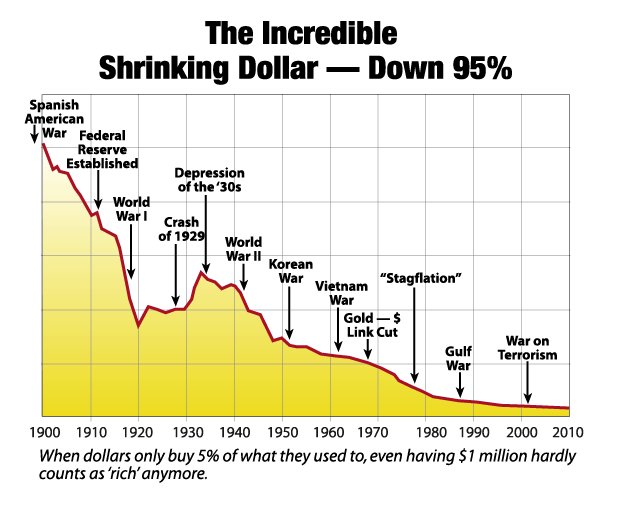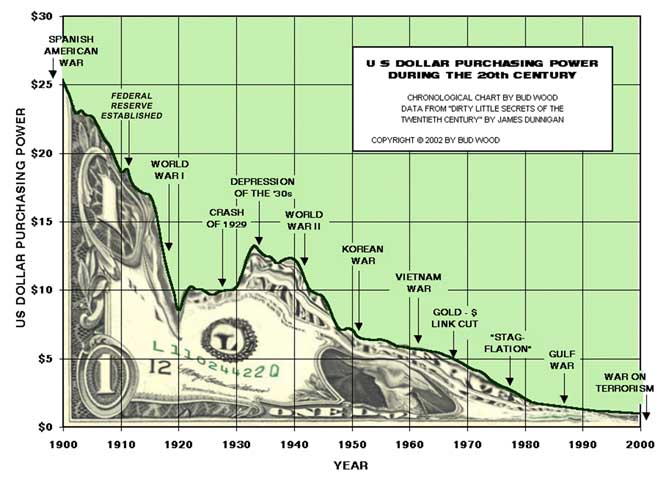Abstract: The total amount of wealth that has been taken by currency issuers over the last century is usually estimated at about 95%. This estimate is based on data of price inflation, which given enough time will reflect the monetary supply inflation (issuance) created by issuers. We show here that this estimate is off by at least a factor of ten, and due to time delay the estimate is off by another factor of 10. The real loss due to our idiocy and treason inherent in accepting privately issued currency is greater than 99.5%, and more likely as high as 99.95%.

A typical plot showing the loss of purchasing power of the dollar, used to infer the amount disbursed to issuers.
1- Money supply inflation and price inflation
In a monetary system of privately issued currency, inflation is the lifeblood of the system. Participants jostle for position near the spigots, or in positions in which this blood will trickle down into their coffers. The arrival of newly issued and laundered tokens is referred to as "growth". Some people are able to get their hands on newly issued fiat tokens (dollars, euros, yuan, yen, etc.) easily, while others have to pay dearly for them. This is referred to as interest rate apartheid, because the inequality is well described by the interest rate that people have to pay. For the most privileged, in a fiat system, that rate is negative infinity percent. For those much worse off, not only is the interest rate positive but quite high. An observer is left with a lot of unknowns watching this system in action, in particular: how much did they issue? There is no way to tell how much of a privately issued currency (fiat) has been issued, for obvious reasons.
However, all is not lost for the econometricist of the fiat era. With enough time, issued currency will trickle down through the layers of interest rate apartheid, finding its way into the hands of the general public, and eventually the larger markets will notice its influence. The inevitable result? We will see price inflation.
Understanding all of this, we can in some way quantify how much real wealth the currency issuers have taken from currency users by looking at the eventual price inflation which arrives. Sure, it takes a generation or more for this trickle-down to occur and really affect the prices, but this might be our only metric to see how much the issuers have been issuing. How much have they been issuing?

The idea is simple, that if we take the price of a commodity like a sandwich, we see that 100 years ago the sandwich cost 95% fewer fiat tokens to trade for then it does today. A local eatery might have charged 5 cents for a beer a century ago, today they charge 1 dollar. So, this means that the currency issuers have absconded with 95% of the currency users' wealth, right?
Historical Context
The problem with the above argument is that it ignores historical context. In particular, a lot has changed about the world in the last century apart from just the number of fiat tokens floating around. The technology and infrastructure available today is far greater. How much did it cost for the brewer to make a bottle of beer 100 years ago? One had to find a skilled knowledgeable braumeister then, as recipes were not available on the internet. Making bottles was much harder, as was shipping them. It took more materials and more energy then, and the designs were not as efficient nor were the machines that produced them. Even growing the wheat was more expensive, as huge increases in automation, engines, fertilizers, and even irrigation have made it easier to grow wheat today. Distribution and accounting and business were also much harder then, without computers and the internet. Finding employees was harder, and finding customers, and procuring all the necessary materials. You get the idea. Everything was much harder and more costlier then. A factor of ten here is a reasonable estimate.
What if there had been no monetary supply inflation over the last century, how much would that 5 cent beer cost today? The answer is about a half a penny. It's just way easier today to produce, bottle, and transport the beer. We have massive trucks and interstate highways, we have bottling machines and pumps and computer aided design now. The point here is that it's not just the loss versus the 1918 dollar that we need to consider in our estimate of how much the issuers have taken from the users, it is the loss versus what we would have been able to purchase had the issuers not been issuing. And if the issuers had not been issuing, that 5 cent beer would not cost 5 cents today, it would cost half a penny. That means we are down by not 95% but by 99.5%!
This is what many analysts miss here: the huge wealth that has been generated due to our technological progress and infrastructure. To look at the current economic situation and say "It's OK, we still get by at least as well if not better than we did a few generations ago" is missing completely the potential gains that you have missed out on due to currency issuers taking them from you.
Imagine that unbeknownst to you there were a package of 1000$ in cash shipped to your residence every week. Imagine further that a neighbor has been taking it from your mailbox, so that you didn't even know it was arriving. This is the situation in regards to monetary supply inflation over the last century, as the potential gains of the information age and ubiquitous electric power have been grabbed by currency issuers while fiat currency users are left saying "everything's fine". Well, really the issuance grab has gone well beyond that and well into taking the direct paychecks too.
Delayed Price Inflation
Once we have considered the changes in productivity due to technological infrastructure, we have an additional factor of 10 or more in our calculation of just how bad our idiocy of accepting privately issued currency has affected our bottom line. However there is another factor we will need to consider, namely the delay present between the issuance and the price inflation. This delay is due to the fact that large holdings of a tiny portion of the population don't immediately affect the prices at walmart. Prices have a certain inertia to them and the issued currency won't affect the price until it has trickled down into the economy to the point where a substantial fraction of customers have a piece of this money. One guy in the town with a trillion in cash stored in his garage isn't going to mean the local shops jack up the prices - until the guy hires a small army of extremely well paid servants who also shop there.
If we assume that this process takes roughly a generation (this depends highly on spending habits and population size), then we are left with the conclusion that issuers had taken 99.5% of the nation's wealth as of 35 years ago. This means another factor of 10 in our estimates of how much the issuers have taken as of today. After all, the money supply gains since we all started talking about quantitative easing still haven't affected food and energy costs. OK they may have affected some real estate markets and the most expensive art auctions, but not what we typically refer to when we look at price inflation.
The final estimate? 99.95% of all capital has been collected by money issuers and those whom they have bestowed financial favor upon in the last century. No wonder we are desperate to pull out all the natural resources we can, it's really hard to stay ahead in this game (hint - you never will unless you are an issuer). The whole thing is just inexcusable really, the enabling of wholesale corruption and squandering of resources by people who should know better. Sure, it's an episode you might expect of primitive man, an interesting story from marco polo and a lesson to learn from. But in the 21st century? People are engaging in the crime of accepting privately issued currency for real goods and services? Really?
2 Replies to “The complete story of price inflation in the last century”